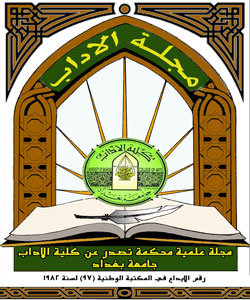Age Impact on the Use of Politeness Strategies in Online Interaction by EFL Students in Al-Anbar Distinguished School for Girls
DOI:
https://doi.org/10.31973/aj.v2i145.4195الكلمات المفتاحية:
Age differences، Distinguished Schools، Politeness strategies، Online interactionالملخص
The present paper concentrates on the linguistic behaviors prevailing in EFL students in Al-Anbar distinguished school for Girls. These behaviors are displayed through the choice of language, and politeness strategies employed by EFL students in their interaction with each other. Thus, the population of the current study is EFL students from the second intermediate and fifth preparatory classes in the secondary distinguished school for girls in Al-Anbar Province in the first and second semester of their academic year 2021-2022. Based on this population, a total of 40 students have volunteered to participate in this study. The age of the participants is in-between (14-17) years. Consequently, more than 30 samples of their online messages are collected by the researcher. These messages are sent by the participants of the study via Whatsapp groups established by the teachers of English language in this secondary distinguished school. To deeply explore the politeness strategies and to find the difference in age for these groups, these messages are analyzed by adopting the qualitative content analysis technique informed by Brown’s and Levisohn’s theory (1987) of politeness strategies. The findings reveal that EFL students from that school utilize various politeness strategies. Based on the frequency of these strategies, the researcher concludes that the age differences among participants play a pivotal role in determining the application and the choices of politeness strategies through their online interaction. As a result, the data of the present paper shows that participants from fifth stage are more aware and knowledgeable to these strategies than those who are from second intermediate stage.
التنزيلات
المراجع
Ammaida, Yunisaa. (2020). Politeness Strategies of the Comments Toward Trump’s Instagram Post on International Women’s Day. Fakultas Adab dan Bahasa IAIN Surakarta.
AbdulGhafoor, Najla Hais and Challob, Ala'a Ismael (2021). The Influence of Using Online Discussion on Developing EFL Students’ Grammar Knowledge. Korean Journal of English Language and Linguistics, 21: 837-855.
Bella, Spyridoula.( 2009). Invitations and politeness in Greek: The age variable. Journal of Politeness Research 5, 243-271.
Brown, P., & Levisohn, S. C. (1987). Politeness: Some Universal in Language Usage. New York, USA: Cambridge University Press.
Creswell, J. W. (2007). Qualitative inquiry and research design: Choosing among five approaches (2nd ed.). Thousand Oaks, CA: Sage.
Dimitrova-Galaczi, E. (2002). Issues in The Definition and Conceptualization of Politeness. Columbia University: TESOL & Applied Linguistics 2.1, 1-20.
Emara, Ingy. (2017). The Impact of Aging on Egyptian Adults’ Use of Politeness Strategies.
Bashir, Rahat. (2022). Effects of Age on Politeness and Faithfulness of Identity- A Pakistani Punjabi Community Analysis. Webology. Volume 19, Number 1.
Gudykunst, W. & Hall, B.J. (1994). Strategies for effective communication and adaptation in intergroup contexts. In J.A. Daly & J.M. Wiemann (Eds.). Strategic interpersonal communication. New York: Psychology Press.
Kadar, Daniel Z. & Bargiela-Chiappini, Francesca.(2011). Institutional Politeness in (South) East Asia. Journal of Asian Pacific Communication.
Rifai, Ahmad &Cirebon, Iain syekh Nurjat. (2022). Analising EFL Teacher’s Politeness Strategies in Classroom Interaction. Foreign Language Instruction Probe.
التنزيلات
منشور
إصدار
القسم
الرخصة

هذا العمل مرخص بموجب Creative Commons Attribution 4.0 International License.
:حقوق الطبع والنشر والترخيص
بالنسبة لجميع البحوث المنشورة في مجلة الآداب، يحتفظ الباحثون بحقوق النشر. يتم ترخيص البحوث بموجب ترخيص Creative Commons CC BY 4.0 المفتوح ، مما يعني أنه يجوز لأي شخص تنزيل البحث وقراءته مجانًا. بالإضافة إلى ذلك ، يجوز إعادة استخدام البحث واقتباسه شريطة أن يتم الاستشهاد المصدر المنشور الأصلي. تتيح هذه الشروط الاستخدام الأقصى لعمل الباحث وعرضه.
:إعادة إنتاج البحوث المنشورة من الناشرين الآخرين
من الضروري للغاية أن يحصل الباحثون على إذن لإعادة إنتاج أي بحث منشورة (أشكال أو مخططات أو جداول أو أي مقتطفات من نص) لا يدخل في نطاق الملكية العامة أو لا يملكون حقوق نشرها. يجب أن يطلب الباحثون إذنًا من مؤلف حقوق النشر (عادة ما يكون الناشر).
يطلب الإذن في الحالات التالية:
بحوثك الخاصة المنشورة من قِبل ناشرين آخرين ولم تحتفظ بحقوق النشر الخاصة بها.
مقتطفات كبيرة من بحوث أي شخص أو سلسلة من البحوث المنشورة.
استخدم الجداول والرسوم البيانية والمخططات والمخططات والأعمال الفنية إذا لم يتم التعديل عليها.
الصور الفوتوغرافية التي لا تملك حقوق لنشرها.
لا يطلب الإذن في الحالات التالية:
إعادة بناء الجدول الخاص بك مع البيانات المنشورة بالفعل في مكان آخر. يرجى ملاحظة أنه في هذه الحالة يجب عليك ذكر مصدر البيانات في شكل "بيانات من ..." أو "مقتبس من ...".
تعتبر عروض الأسعار القصيرة معقولة الاستخدام العادل ، وبالتالي لا تتطلب إذنًا.
الرسوم البيانية ، الرسوم البيانية ، المخططات ، الأعمال الفنية التي أعاد الباحث رسمها بالكامل والتي تم تغييرها بشكل ملحوظ إلى درجة لا تتطلب الاعتراف.
الحصول على إذن
لتجنب التأخير غير الضروري في عملية النشر ، يجب أن تبدأ في الحصول على أذونات في أقرب وقت ممكن. لا يمكن لمجلة الآداب نشر بحث مقتبس من منشورات أخرى دون إذن.
قد يمنحك مالك حقوق الطبع والنشر تعليمات بشأن شكل الإقرار الواجب اتباعه لتوثيق عمله ؛ بخلاف ذلك ، اتبع النمط: "مستنسخ بإذن من [المؤلف] ، [كتاب / المجلة] ؛ نشره [الناشر] ، [السنة]." في نهاية شرح الجدول ، الشكل أو المخطط.
.jpg)























